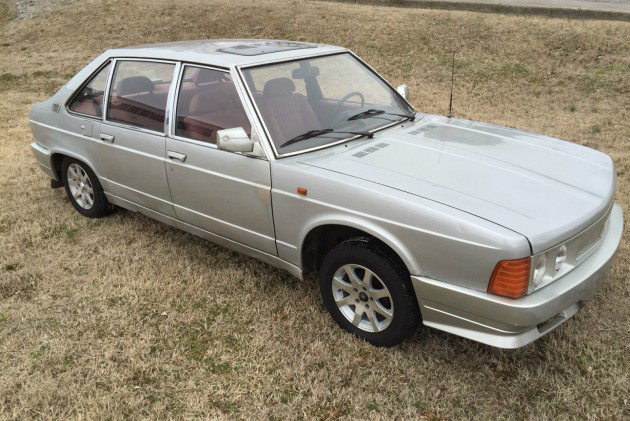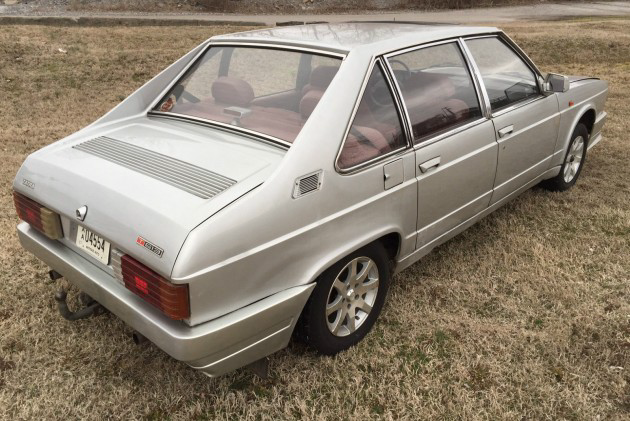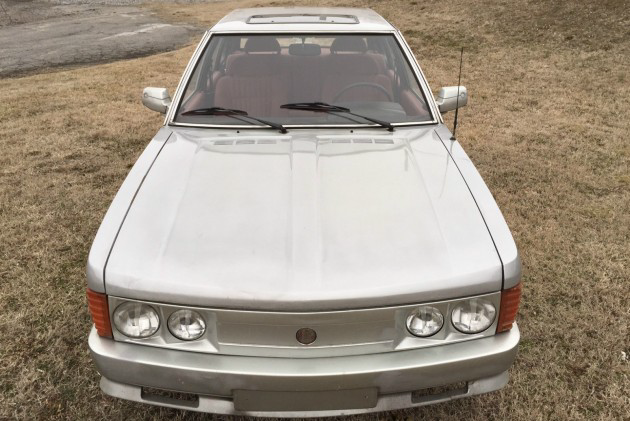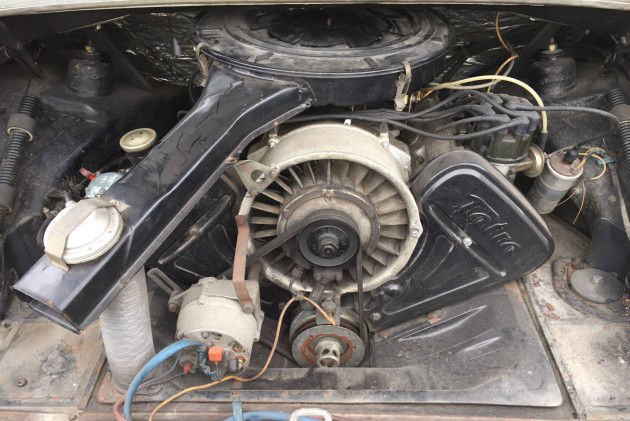The Only One In Town! 1976 Tatra T613-3
If you aren’t familiar with Tatras, they have always been somewhat out there from an engineering point of view. Think about it–a rear-mounted, air-cooled, overhead cam V8 is the power plant. That huge nose? It’s for storage area only! The seller says buy it and you’ll have the only one in town, and I’ll bet they are correct in 99.99% of the USA. The Tatra is located in Nashville, Tennessee and is listed for sale here on eBay at no reserve. Thanks to Jim S. for alerting us to this unusual find!
The somewhat different profile of the car is at least partially due to the the unusual engine configuration. Actually, looking at the small vents, I don’t know how the engine gets enough air to keep it cool, but apparently it does.
I see some Volkswagen 412 in the nose, although the 613 was designed by Vignale, and the 412 by Brooks Stevens, so any resemblance is circumstantial. Cosmetically, this car has some rust, and is notably characterized by the seller as a car you don’t want plan to fly in and drive back to Oregon.
Yeah, trunks are usually boring–but this is a frunk! I wish the seller had made a little more effort to clean the area up, but at least we can see there’s no structural rust around the strut towers.
Honestly, I was surprised to see both the condition and the structural design of these seats. I don’t think they’d be out of place in any European luxury car of the mid-1980’s. The condition is nice as well. The Tatra is said to have 179,697 kilometers (111,659 miles) on the odometer, which says a lot for the seat upholstery! The seller says the carpet is “garbage” (I like the way they don’t mince words!) and I’m guessing that’s a custom set on this side of the Atlantic.
Here’s the engine. Looking at it, I was pretty intimidated, so I decided to try the “Jamie Test For Parts Availability” (JTFPA). This consists of looking the car up on RockAuto.com and seeing what parts are available. It’s telling that a few of the more obscure cars I own have part counts in the single digits. This car was a new low for me, though–there are exactly zero parts listed for any post-1968 Tatras! I did find this source of companies that offer auto spares (there were several for truck spares) but, of course, they are all in Slovakia. The price is pretty steep, but where are you going to find another one? Would you take this oddball on?
Auctions Ending Soon
 2006 Ford Mustang Saleen S281 SCBid Now9 hours$15,000
2006 Ford Mustang Saleen S281 SCBid Now9 hours$15,000
 2002 Subaru Impreza WRXBid Now3 days$333
2002 Subaru Impreza WRXBid Now3 days$333
 1975 Chevrolet Corvette ConvertibleBid Now3 days$3,000
1975 Chevrolet Corvette ConvertibleBid Now3 days$3,000
 1964 Ford F-100 Camper CustomBid Now3 days$2,000
1964 Ford F-100 Camper CustomBid Now3 days$2,000
 2006 Jeep Wrangler SportBid Now5 days$10,500
2006 Jeep Wrangler SportBid Now5 days$10,500







Comments
~ Nashville, ehh? It is certainly is not the only Tatra in that town. Go to the Lane Motor Museum to see a variety of them, including this replica 1942 Tatra prototype Aeroluge.
~ 1942 Tatra prototype Aeroluge.
~ Sorry, the system is not accepting the upload images.
As Scot said above, this isn’t the only one in Nashville. This car belongs to the Lane Motor Museum and is one of two in their collection. This one is the worse of the two, so I’d bet that’s why their selling it. When I was there in December, this car was sitting in their heated basement, so it’s in good hands. If anyone can find parts for this thing, it’s the Lane; they have a floor to ceiling shelves full of parts covering one wall in their basement, and I saw at least two boxes labeled Tatra.
This was not what I was expecting when I saw Tatra. I love the older models though this too is pretty cool.
Once you secure your source parts won’t be that big a deal. Guys are still running the vintage Tatras arent they?
I’d roll this model but no way I’d pay that much for one showing so much rust repair in my future.
“Good morning, AutoPlace, how can I help you”? “Hi, I’d like a throw-out bearing for a 1976 Tatra T613-3”.
http://3.bp.blogspot.com/-3xEYbv2ovDc/VCP0fYWxsgI/AAAAAAAANMo/FT0b3BbLMQE/s1600/Funny-men-laughing-cartoon-you-want-it-when.jpg
A large expensive rear mounted air cooled V8-powered car in Eastern Europe.
I just can’t figure how this could have failed.
Dolphin —
These were quite successful in eastern Europe for over 20 years, highly coveted, at least until western cars became available. The 613 continued on until 1997, but even with Bosch fuel injection, because the gearbox was integral with the engine sump, there was no possibility of adding an automatic gearbox, and there was little demand for luxury cars without an auto’box.
I had the pleasure of driving a Tatra 613 all over England for a couple of weeks, and it really was a very reliable & comfortable automobile. Plenty of power, even with 4 people & luggage. I’ve owned a couple of the older Tatra cars, they are very reliable & very easy to maintain.
I would love to own this car, but I’ve got too many projects right now!
I am familiar. These are really engineered well. I love it, but I don’t have anymore room or money and the wife said NO!
Well Bill I guess you and I have very different ideas about what makes for success for a particular car model.
If you check how many 613s were made over how many years, and sold to whom, and then think about how well the number sold might have offset the development and tooling costs, you might understand the reason for my comment. There’s more that could be said, but those are the main points. I think the Tatra 613 numbers would not be considered a viable business for most carmakers. Maybe the passenger car business that Tatra was running did not need to cover costs and turn a profit. But if that’s true, then that’s a very different scenario than other carmakers face.
How many were made? What was the cost of tooling? What was the profit per unit? How did this model fit into production with their other products? Why did they continue producing the car for twenty years if it wasn’t successful?
I look forward to learning more thanks in advance.
The last 2 questions I can answer;
As everything was controlled by the government, Tatra was told to produce a large sedan [the 613 series], and a line of large commercial trucks, from smaller flat bed & 5 tonne dumps, to huge 4, 6 & 8 axle vehicles with all wheel drive & multiple steering axles. And yes, they were air cooled diesel engines, mostly V12, but a few V8s to for the smaller trucks.
With the government controlling all aspects of the manufacturing system, prices were fixed at all stages of manufacturing. So if a raw material needed to produce a product was sold at a government controlled price, and the price resulted in a financial loss, the loss was covered by the government. This meant that because most of the pieces required to build something like an automobile or truck were sold to the vehicle manufacturer at a loss, the vehicle could be made at a price that made it possible to sell all over the world at a lower price.
In the case of the Tatra 613, almost all the production was purchased by governments all over the eastern bloc. VERY few were sold to private individuals or companies. There was no need to make a profit. So you have a closed economy, where western cars were not allowed to be sold. The Tatra 613 was, in comparison, like a big Buick here in America, and all you could buy [in a car of that size or value] was the Buick. No competition. It was a damn good, reliable, & decent looking vehicle, so demand was equal to the production.
And as the saying goes; About the only chance an average eastern bloc citizen had of riding in a Tatra 613, was when the police picked you up at 2am from your home & whisked you away!
So in the eastern block, the Tatra 613 was VERY successful.
Once the iron curtain fell and the former eastern bloc countries were overrun by worn-out older western European cars being sold cheap, suddenly no one wanted any of the eastern bloc vehicles. [There were accurate reports of Trabants in good condition being hefted into open top dumpsters ’cause no one wanted them.]
Tatra was by then on it’s own, with ZERO government backing. Initially, the big trucks continued selling well, but their prices began to rise steeply due to both increasing costs from suppliers who also had no government support, & their unorthodox designs, including the central backbone chassis & drive line [but that’s another story]. Sales & production dropped.
I’ve discussed this with several people involved in the attempt to modernize the Tatra products [both truck & car]. While they were able to meet the European emissions requirements into the late 1990s, the money was simply not there to re-design the air-cooled V8 to accept an automatic gearbox, and I was told it was going to be increasingly difficult to meet future emissions regulations, as the engine was a 1970s design. There is a reason 95% of all Mercedes & BMW luxury vehicles were equipped with automatics — that’s what the public wanted. Tatra never produced an automatic gearbox.
So after building a total [I believe] of 7 cars in 1997, they stopped production of the 613-based cars. I have been told they wanted to make a few cars in 1997 as it was the 100th anniversary of Tatra, and the company wanted to be able to say they made cars for 100 years.
The trucks still sell well in the countries that had established dealerships and parts supplies, however they have not been able to make inroads into the established western markets.
Thanks Bill. I appreciate your coming in here and providing all this information.
You have confirmed everything that I was aware of about these Tatras (and provided a lot more information besides), but I got that information off the web and I thought that Dave Wright would come on here again and say how Google had failed me….again.
I think you know a great deal about Tatra, and you have talked to other people who do also, so thank you.
What your information says is that in the East Bloc back then a company that’s under the thumb of a dictatorship can produce about 11 thousand nice cars mainly for the big shots over the space of a couple of decades or so, but when the orders from government officials dry up production slows to a trickle and then stops.
Not exactly the way the car industry works in the rest of the known universe. Regular carmakers in free countries need to meet legislative requirements, satisfy customer preferences, and also cover their costs and make a profit to survive and build the next new model.
You can look up some of the numbers, but I assume you are joking when you ask for numbers on the cost of tooling and profit.
Find some numbers yourself and then I think you will be better able to understand. Then we can talk.
Nah you’ve answered my real question.
Contrary to your beliefs companies in Czechoslovakia still had to turn profit to exist. Whole system would not last over 40 years on loses. Production of T603 or T613 was subsidized by profit from heavy truck sales. They just couldn’t go on world lending market to raise cash.
This is exactly why I subscribe to Barn Finds – I’ve never seen of/heard of one of these before. Thanks for the find – unique hitch out back…
Tball — Unlike North America where there are multiple sizes of ball hitches, and 3 different receiver sizes, since the pulling & tongue weight capability of 95% of tow vehicles is similar to what we would refer to as a Class 2 hitch, they standardized on the size you see there.
Licensing is also different. In the UK, the trailer is certified to be pulled behind ONE specific vehicle, hence the trailer also displays the license plate of the towing vehicle. Yep, this means if you want to borrow your friends trailer to go to an “AutoJumble” for the weekend, you’ve got to borrow his car too! In most of Europe, the same applies to a trailer with a total weight of under 750kg [1,650 #]. Over that weight, the trailer gets it’s own license number.
It gets more complicated if you have a larger vehicle to tow a larger payload [like a Chevy Suburban & a large Airstream]. If you have a passenger car driver’s permit issued prior to 1980, you can operate a vehicle/trailer combination of any size or weight, except for commercial trucks.
If you’re driver’s permit was issued in 1981 or later, you are restricted to a vehicle/trailer combo with a combined weight of 3.5 tonnes [about 8,000#] or less. Above that requires a Commercial permit C-1. I’m not sure exactly when it changes, but in Europe I’ve seen large American travel trailers that are towed by a ring [pintle] hitch seen on construction trailers, the tow vehicle being a commercial truck.
Dolphin —
Even with a large production run of vehicles like the Trabant [over 3.7 million made] it’s still the same situation as the Tatra. During the iron curtain days, Trabants were terrible cars compared to the west, but when it was the only car available to the masses [who waited years to be allowed to buy one — no credit, only cash], citizens were proud to have finally bought a vehicle! In the old DDR you could see Trabants everywhere, because they were sold at a loss, and therefore CHEAP! [DDR = East Germany]
The Trabant had a gas welded [brazed] tube mono-body frame, the actual body panels were not glass fibre and resin, but “Duroplast” a mix of resin & chopped up clothing & rags, the fibers arranged just as it would be in glass mats. When the resin got a crack in it, the cloth fibers rotted, and I remember seeing small weeds growing in the body cracks! The fuel gauge was a little plastic stick clipped under the hood next to the tank, and you stuck it down the filler hole to see how much fuel you had left. Making the cars was very labor intensive, but then again labor was cheap, and it didn’t matter if it actually cost about double to make, against what it sold for!
What does this mean?
“I’d roll this model but no way I’d pay that much for one showing so much rust repair in my future.” (bobsmyuncle)
[Sorry, English is not my first language]
The story of 613 and 700 is fascinating and quite well-documented. And technically, the cars are advanced (for their time).
I like the car, design, history, powerplant, all of it appeals to me.
However at this price, plus the cost of rust repair, I (personally) can’t see the value.
A perfect version, at this price or near it would tempt me to do something rash.
There was a LWB version owned by a Tatra collector in London, Ontario, looked great, very good price last fall (ad in HMN)
But is there a description of the rust repair required?
This was 15k a year ago, wait another 2 years and it will be priced right. Which also means the photos are not current.
http://www.ebay.com/itm/Other-Makes-Sedan-1976-tatra-t-613-3-/281618924255?forcerrptr=true&hash=item4191cbc2df&item=281618924255&pt=US_Cars_Trucks
I hope it is allowed to post a link to another site: http://www.coys.co.uk/cars/1981-tatra-t613-3
this is not 1976 Tatra It is 1986 or newer
Look at the tail lights and the front of the vehicle
Mike,
Because many Tatra 603 and 613 cars were government owned, they were routinely sent back to the Tatra factory for “rebuilding”. This involved updated mechanicals as well as updated lighting and trim. So this Tatra is likely a 1976 car with factory updates.
This Tatra I like